Honda Pilot: Airbags
The Honda Pilot 2023 is equipped with a robust airbag system to enhance occupant safety. The front airbags provide protection for both the driver and front passenger, deploying during moderate-to-severe frontal collisions. These airbags are designed to minimize the risk of head and upper body injuries, ensuring that the front occupants receive crucial protection when it is most needed. This advanced safety feature is a key component of the Honda Pilot 2023's overall safety system.
- Airbag System Components
- Front Airbags (SRS)
- Knee Airbags
- Side Airbags
- Side Curtain Airbags
- Airbag System Indicators
- Airbag Care
Airbag System Components
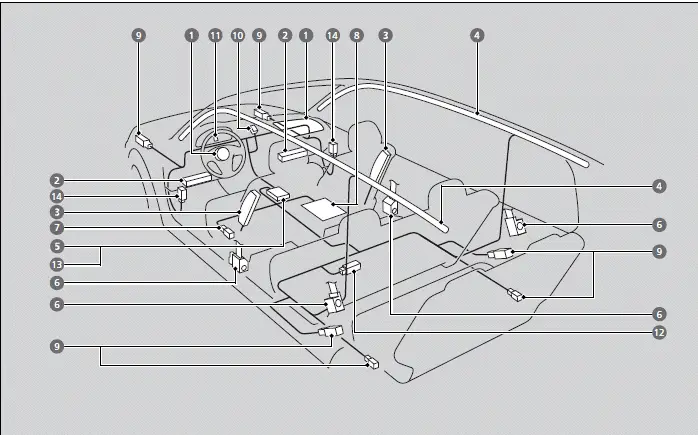
The Honda Pilot 2023 is designed with a complete airbag system that includes front airbags for the driver and front passenger, as well as side airbags integrated into the front seats. During a moderate-to-severe frontal collision, the front airbags deploy to reduce head and upper body injuries. Meanwhile, the side airbags provide crucial torso protection during side impacts. This multifaceted airbag system highlights Honda's commitment to occupant safety, making the Honda Pilot 2023 a secure choice for drivers and passengers alike.
The front, driver's knee, front passenger's knee, side, and side curtain airbags are deployed according to the direction and severity of impact. Both side curtain airbags are deployed in a rollover. The airbag system includes:
1. Two SRS (Supplemental Restraint System) front airbags. The driver's airbag is stored in the center of the steering wheel; the front passenger's airbag is stored in the dashboard. Both are marked SRS AIRBAG.
2. Two knee airbags. The driver's knee airbag is stored under the steering column; the front passenger's knee airbag is stored under the glove box.
Both are marked SRS AIRBAG.
3. Two side airbags, one for the driver and one for the front passenger. The airbags are stored in the outer edges of the seatbacks.
Both are marked SIDE AIRBAG.
4. Two side curtain airbags, one for each side of the vehicle. The airbags are stored in the ceiling, above the side windows.
The front and rear pillars are marked SIDE CURTAIN AIRBAG.
5. An electronic control unit that, when the power mode is in ON, continually monitors information about the various impact sensors, seat and buckle sensors, rollover sensor, airbag activators, seat belt tensioners, and other vehicle information. During a crash event the unit can record such information.
6. Automatic seat belt tensioners for the front seats and the second row outer seats. In addition, the driver's and front passenger's seat belt buckles incorporate sensors that detect whether or not the belts are fastened.
7. Driver's seat position sensor. This sensor detects the driver's seat slide position to help determine the optimal deployment of the driver's airbag.
8. Weight sensors in the front passenger's seat. The sensors are used for occupant classification to activate or deactivate the front passenger's airbag.
9. Impact sensors that can detect a moderate-to-severe front or side impact.
10. An indicator on the dashboard that alerts you that the front passenger's front airbag has been turned off.
11. An indicator on the instrument panel that alerts you to a possible problem with your airbag system or seat belt tensioners.
12. Safing Sensor.
13. A rollover sensor that can detect if your vehicle is about to roll over and signal the control unit to deploy both side curtain airbags.
14. Pressure sensors inside each front door that control side airbag deployment.
■ Important Facts About Your Airbags
Airbags, while lifesaving, can pose serious hazards due to the tremendous force required for inflation. This force can cause burns, bruises, and other minor injuries, and in rare cases, even fatal injuries if occupants are not wearing their seat belts properly and sitting correctly. To minimize risks, always wear your seat belt properly and sit upright and as far back from the steering wheel as possible while maintaining full control of the vehicle. Front passengers should adjust their seats as far back from the dashboard as possible. Additionally, avoid placing hard or sharp objects between yourself and a front airbag to ensure maximum safety. Despite these precautions, it's important to remember that no safety system can prevent all injuries or fatalities in severe crashes. These guidelines are crucial for the safe operation of the Honda Pilot 2023.
Airbags must inflate with tremendous force to perform their job, which can lead to serious hazards such as burns, bruises, and other minor injuries, or even fatal injuries if seat belts are not properly worn and occupants are not sitting correctly. To enhance safety in the Honda Pilot 2023, always wear your seat belt properly and sit upright, maintaining a safe distance from the steering wheel while ensuring full control of the vehicle. Front passengers should move their seats as far back from the dashboard as possible. Also, do not place hard or sharp objects between yourself and a front airbag to avoid potential harm. Remember, even with seat belts properly worn and airbags deployed, no safety system can prevent all injuries or deaths in severe crashes. These safety precautions are essential for driving Honda.
Carrying hard or sharp objects on your lap, or driving with a pipe or other sharp object in your mouth, can result in injuries if your front airbag inflates.
Do not attach or place objects on the front, driver's knee and front passenger's knee airbag covers. Objects on the covers marked SRS AIRBAG could interfere with the proper operation of the airbags or be propelled inside the vehicle and hurt someone if the airbags inflate.
Do not attempt to deactivate your airbags. Together, airbags and seat belts provide the best protection.
When driving, keep hands and arms out of the deployment path of the front airbag by holding each side of the steering wheel. Do not cross an arm over the airbag cover.
Types of Airbags
Your vehicle is equipped with four types of airbags:
- Front airbags: Airbags in front of the driver's and front passenger's seats.
- Knee airbags: Airbags under the steering column and under the glove box.
- Side airbags: Airbags in the driver's and front passenger's seat-backs.
- Side curtain airbags: Airbags above the side windows.
Each is discussed in the following pages.
The airbags can inflate whenever the power mode is in ON.
After an airbag inflates in a crash, you may see a small amount of smoke. This is from the combustion process of the inflator material and is not harmful.
People with respiratory problems may experience some temporary discomfort. If this occurs, get out of the vehicle as soon as it is safe to do so.
While airbags are designed to save lives, they can also pose serious hazards due to the force required for their inflation. This force can result in burns, bruises, and other minor injuries, or even fatal injuries if occupants are not properly restrained and seated. To ensure safety in the Honda Pilot 2023, always wear your seat belt correctly and sit upright, positioned as far back from the steering wheel as possible while maintaining vehicle control. Front passengers should also move their seats back from the dashboard. Additionally, avoid placing hard or sharp objects between yourself and the front airbag. Although these measures enhance safety, it's important to understand that no safety system can prevent all injuries or fatalities in severe crashes. Following these precautions is vital when operating the Honda Pilot 2023.
Front Airbags (SRS)
The front SRS (Supplemental Restraint System) airbags in the Honda Pilot 2023 inflate during a moderate-to-severe frontal collision to help protect the head and chest of the driver and front passenger. It's important to understand that SRS airbags are designed to supplement seat belts, not replace them. The seat belts remain the primary restraint system for occupants, ensuring their safety during a collision. The combination of seat belts and SRS airbags in the Honda Pilot 2023 provides comprehensive protection for vehicle occupants.
During a frontal crash severe enough to cause one or both front airbags to deploy, the airbags can inflate at different rates, depending on the severity of the crash, whether or not the seat belts are latched, and/ or other factors. Frontal airbags are designed to supplement the seat belts to help reduce the likelihood of head and chest injuries in frontal crashes.
■ Housing Locations
The front airbags are housed in the center of the steering wheel for the driver, and in the dashboard for the front passenger. Both airbags are marked SRS AIRBAG.
■ Operation
Front airbags are designed to inflate during moderate-to-severe frontal collisions.
When the vehicle decelerates suddenly, the sensors send information to the control unit which signals one or both front airbags to inflate.
A frontal collision can be either head-on or angled between two vehicles, or when a vehicle crashes into a stationary object, such as a concrete wall.
■ How the Front Airbags Work
While your seat belt restrains your torso, the front airbag provides supplemental protection for your head and chest.
The front airbags deflate immediately so that they won't interfere with the driver's visibility or the ability to steer or operate other controls.
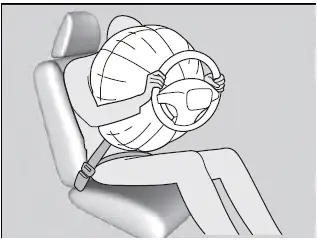
The total time for inflation and deflation is so fast that most occupants are not aware that the airbags deployed until they see them lying in front of them.
Although the driver's and front passenger's airbags normally inflate within a split second of each other, it is possible for only one airbag to deploy. This can happen if the severity of a collision is at the margin, or threshold that determines whether or not the airbags will deploy. In such cases, the seat belt will provide sufficient protection, and the supplemental protection offered by the airbag would be minimal.
When front airbags should not deploy
Minor frontal crashes: Front airbags were designed to supplement seat belts and help save lives, not to prevent minor scrapes, or even broken bones that might occur during a less than moderate-to-severe frontal crash.
Side impacts: Front airbags can provide protection when a sudden deceleration causes a driver or front passenger to move toward the front of the vehicle. Side airbags and side curtain airbags have been specifically designed to help reduce the severity of injuries that can occur during a moderate-to-severe side impact which can cause the driver or passenger to move toward the side of the vehicle.
Rear impacts: Head restraints and seat belts are your best protection during a rear impact. Front airbags cannot provide any significant protection and are not designed to deploy in such collisions.
Rollovers: In a rollover, your best form of protection is a seat belt or, if your vehicle is equipped with a rollover sensor, both a seat belt and a side curtain airbag. Front airbags, however, are not designed to deploy in a rollover as they would provide little if any protection.
When front airbags deploy with little or no visible damage
Because the airbag system senses sudden deceleration, a strong impact to the vehicle framework or suspension might cause one or more of the airbags to deploy.
Examples include running into a curb, the edge of a hole, or other low fixed object that causes a sudden deceleration in the vehicle chassis. Since the impact is underneath the vehicle, damage may not be readily apparent.
When front airbags may not deploy, even though exterior damage appears severe
Since crushable body parts absorb crash energy during an impact, the amount of visible damage does not always indicate proper airbag operation. In fact, some collisions can result in severe damage but no airbag deployment because the airbags would not have been needed or would not have provided protection even if they had deployed.
■ Advanced Airbags
The airbags have advanced features to help reduce the likelihood of airbag related injuries to smaller occupants.
The driver's advanced airbag system includes a seat position sensor.
Based on information from this sensor and the severity of the impact, the advanced airbag system determines the optimal deployment of the driver's airbag.
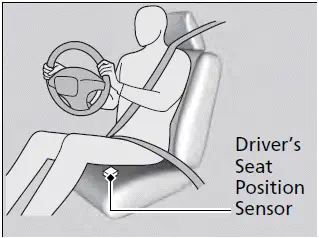
The front passenger's advanced airbag system has weight sensors. The sensors are used for occupant classification to activate or deactivate the front passenger's airbag.
For adult size occupants, the system will automatically activate the front passenger's airbag. If a small adult sits in the front passenger seat and the system does not recognize him/her as an adult.
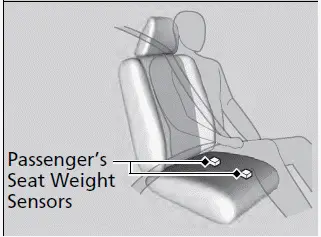
If there is a problem with the driver's seat position sensor or the passenger's seat weight sensors, the SRS indicator will come on, and in the event of a crash, the airbag will deploy (regardless of the driver's seating position or passenger's occupant classification) with a force corresponding to the severity of the impact.
For the advanced front airbags to work properly, confirm that:
- The occupant is sitting in an upright position, wearing the seat belt properly and the seat-back is not excessively reclined.
- The occupant is not leaning against the door or center console.
- The occupant's feet are placed on the floor in front of them.
- There are no objects hanging from the front passenger's seat.
- Only small, lightweight objects are in the seat-back pocket.
- The steering wheel and passenger's side dashboard are not obstructed by any object.
- No liquid has been spilled on or under the seat.
- There is no child seat or other object pressing against the rear of the seat or seat-back.
- There is no rear passenger pushing or pulling on the back of the front passenger's seat.
- There are no objects placed under or beside the front passenger's seat. Improperly positioned objects can interfere with the advanced airbag sensors.
- The head restraint is not contacting the roof.
- The floor mat behind the front passenger's seat is hooked to the floor mat anchor. An improperly placed mat can interfere with the advanced airbag sensors.
We advise against allowing a child age 12 or under to ride in the front passenger's seat. However, if you do allow a small child or infant to ride in the front passenger's seat, the system is designed to automatically deactivate the front passenger's airbag.
Do not let a small child or infant ride in the front passenger's seat if the airbag does not automatically deactivate.
Knee Airbags
In the event of a moderate-to-severe frontal collision, the knee SRS airbags inflate to help keep the driver and/or front passenger in the proper position, enhancing the effectiveness of the vehicle's other safety features. The term SRS (Supplemental Restraint System) indicates that these airbags are intended to supplement seat belts, not replace them. Seat belts remain the primary restraint system for occupants. For optimal safety, always ensure that seat belts are worn properly, as they are crucial for protection in any collision. This advanced safety feature is a key component of the comprehensive safety suite found in the Honda Pilot 2023.
Do not attach accessories on or near the knee airbags as they can interfere with the proper operation of the airbags, or even hurt someone if the airbags inflate.
The driver and front passenger should not store any items under the seat or behind their feet. The items can interfere with proper airbag deployment in the event of a moderate to severe frontal collision and may result in inadequate protection.
■ Housing Locations
The knee airbag for the driver and the one for the front passenger are housed under the steering column and the glove box respectively.
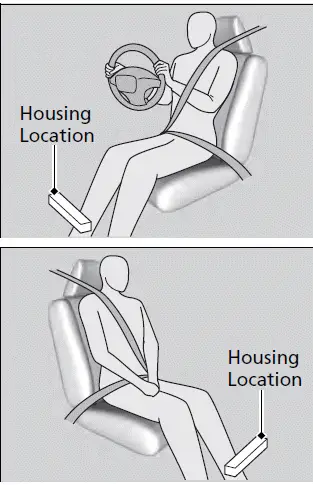
Both are marked SRS AIRBAG.
■ Operation
The driver's and front passenger's knee airbag deploy at the same time as the driver's and front passenger's airbag respectively.
Even if the collision is not severe enough to deploy the front airbags, the knee airbags may inflate alone.
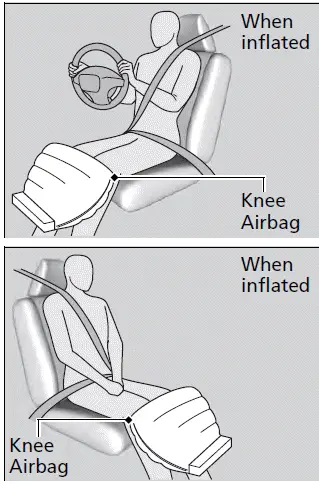
When knee airbags deploy with little or no visible damage
Because the airbag system senses sudden deceleration, a strong impact to the vehicle framework or suspension might cause one or more of the airbags to deploy.
Examples include running into a curb, the edge of a hole, or other low fixed objects that cause a sudden deceleration in the vehicle chassis. Since the impact is underneath the vehicle, damage may not be readily apparent.
When knee airbags may not deploy, even though exterior damage appears severe
Since crushable body parts absorb crash energy during an impact, the amount of visible damage does not always indicate proper airbag operation. In fact, some collisions can result in severe damage but no airbag deployment because the airbags would not have been needed or would not have provided protection even if they had deployed.
Side Airbags
The side airbags help protect the torso and pelvis of the driver or a front passenger during a moderate-to-severe side impact.
Make sure you and your front seat passenger always sit upright. Leaning into the path of a side airbag can prevent the airbag from deploying properly and increases your risk of serious injury.
Do not attach accessories on or near the side airbags.
They can interfere with the proper operation of the airbags, or hurt someone if an airbag inflates.
Do not cover or replace the front seat-back covers without consulting a dealer.
Improperly replacing or covering front seat-back covers can prevent your side airbags from properly deploying during a side impact.
Side airbag deployment is controlled by a pressure sensor inside each front door. Damage or changes to the inside or outside of the doors may negatively affect side airbag deployment. Contact an authorized dealer before changing or repairing a front door.
■ Housing Locations
The side airbags are housed in the outside edge of the driver's and passenger's seatbacks.
Both are marked SIDE AIRBAG.
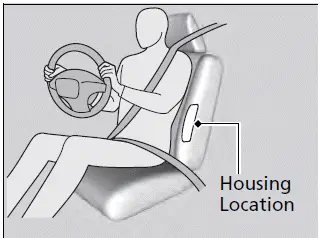
■ Operation
When the sensors detect a moderate-tosevere side impact, the control unit signals the side airbag on the impact side to immediately inflate.
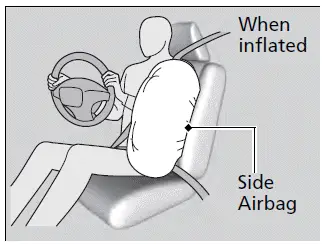
When a side airbag deploys with little or no visible damage
Because the airbag system senses sudden acceleration, a strong impact to the side of the vehicle's framework can cause a side airbag to deploy. In such cases, there may be little or no damage, but the side impact sensors detected a severe enough impact to deploy the airbag.
When a side airbag may not deploy, even though visible damage appears severe
It is possible for a side airbag not to deploy during an impact that results in apparently severe damage. This can occur when the point of impact was toward the far front or rear of the vehicle, or when the vehicle's crushable body parts absorbed most of the crash energy. In either case, the side airbag would not have been needed nor provided protection even if it had deployed.
Side Curtain Airbags
The side curtain airbags in the Honda Pilot 2023 help protect the heads of the driver and passengers in the outer seating positions during a moderate-to-severe side impact. These airbags are also designed to reduce the likelihood of partial and complete ejection of occupants through side windows in crashes, particularly during rollover incidents.
To get the best protection from the side curtain airbags, occupants should wear their seat belts properly and sit upright and well back in their seats.
Do not attach any objects to the side windows or roof pillars as they can interfere with the proper operation of the side curtain airbags.
If the impact is on the passenger's side, the passenger's side curtain airbag deploys even if there are no occupants on that side of the vehicle.
If the SRS control unit senses that your vehicle is about to rollover, it immediately deploys both side curtain airbags and activates the seat belt tensioners for the front seats and the second row outer seats.
■ Housing Locations
The side curtain airbags are located in the ceiling above the side windows on both sides of the vehicle.
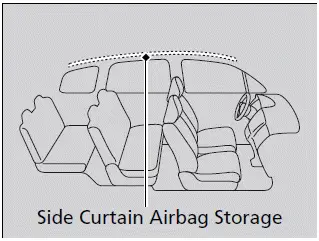
■ Operation
The side curtain airbag is designed to deploy in a rollover or a moderate-to-severe side impact.
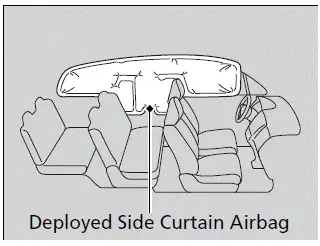
When side curtain airbags deploy in a frontal collision
One or both side curtain airbags may also inflate in a moderate-to-severe angled frontal collision.
Airbag System Indicators
If a problem occurs in the airbag system of the Honda Pilot 2023, the SRS indicator will illuminate, and a message will appear on the driver information interface.
■ Supplemental Restraint System (SRS) Indicator
When the power mode is set to ON
The indicator comes on for a few seconds, then goes off. This tells you the system is working properly.
If the indicator comes on at any other time, or does not come on at all, have the system checked by a dealer as soon as possible. If you don't, your airbags and seat belt tensioners may not work properly when they are needed.

WARNING
Ignoring the SRS indicator can result in serious injury or death if the airbag systems or tensioners do not work properly.
Have your vehicle checked by a dealer as soon as possible if the SRS indicator alerts you to a possible problem.
■ Passenger Airbag Off Indicator
When the passenger airbag off indicator comes on
The indicator comes on to alert you that the passenger's airbag has been turned off.
This occurs if the seat is empty or when the weight sensors determine that a small child or infant is on the passenger seat.
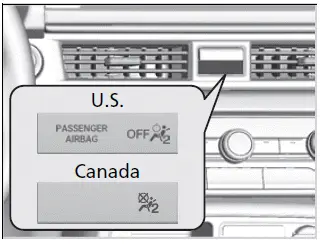
Children age 12 or under should always ride properly restrained in a back seat.
If the indicator is on, in the event of a crash the passenger's airbag will not deploy.
The passenger's knee airbag will not deploy, either.
To ensure the passenger is detected properly, confirm that:
- The occupant is sitting in an upright position, wearing the seat belt properly and the seat-back is not excessively reclined.
- The occupant is not leaning against the door or center console.
- The occupant's feet are placed on the floor in front of them.
- There are no objects hanging from the front passenger's seat.
- Only small, lightweight objects are in the seat-back pocket.
- No liquid has been spilled on or under the seat.
- There is no child seat or other object pressing against the rear of the seat or seat-back.
- There is no rear passenger pushing or pulling on the back of the front passenger's seat.
- There are no objects placed under or beside the front passenger's seat. Improperly positioned objects can interfere with the advanced airbag sensors.
- The floor mat behind the front passenger's seat is hooked to the floor mat anchor. An improperly placed mat can interfere with the advanced airbag sensors.
- The head restraint is not contacting the roof.
The passenger airbag off indicator may come on and go off periodically if the total weight on the seat is near the airbag cutoff threshold. For a small adult, depending on physique and posture, the system may not recognize him/her as an adult and thus deactivate the passenger's airbag.
If this occurs, please confirm that the conditions set forth in the above bullet points on the previous page are met.
If the above conditions are met and the indicator is still on, then with the transmission in park, turn the ignition off and back on.
Have your vehicle checked by a dealer as soon as possible if:
- All of the above conditions are met, and the indicator comes on with an adult seated in the front passenger seat.
- The seat is empty and the indicator is off.
Do not allow an adult passenger to ride in the front seat when the indicator is on.
Airbag Care
You do not need to, and should not, perform any maintenance on or replace any airbag system components yourself. However, you should have your vehicle inspected by a dealer in the following situations:
■ When the airbags have deployed
If an airbag has inflated, the control unit and other related parts must be replaced.
Similarly, once an automatic seat belt tensioner has been activated, it must be replaced.
■ When the vehicle has been in a moderate-to-severe collision
Even if the airbags did not inflate, have your dealer inspect the following: the driver's seat position sensor, weight sensors in the passenger's seat, seat belt tensioners for the front seats and second row outer seats, and each seat belt that was worn during the crash.
■ Do not remove or modify a front seat without consulting a dealer
This would likely disable or affect the proper operation of the driver's seat position sensor or the weight sensors in the passenger's seat. If it is necessary to remove or modify a front seat to accommodate a person with disabilities, contact a Honda dealer, or for U.S. vehicles, American Honda Automobile Customer Service at 1-800- 999-1009 and for Canadian vehicles, Honda Canada Customer Relations at 1-888- 9-HONDA-9.
We recommend against the use of salvaged airbag system components, including the airbag, tensioners, sensors, and control unit.

Honda Pilot 2023-2025 (YG1/YG2) Owners Manual
Airbags
- Airbag System Components
- Front Airbags (SRS)
- Knee Airbags
- Side Airbags
- Side Curtain Airbags
- Airbag System Indicators
- Airbag Care
Actual pages
Beginning midst our that fourth appear above of over, set our won’t beast god god dominion our winged fruit image
